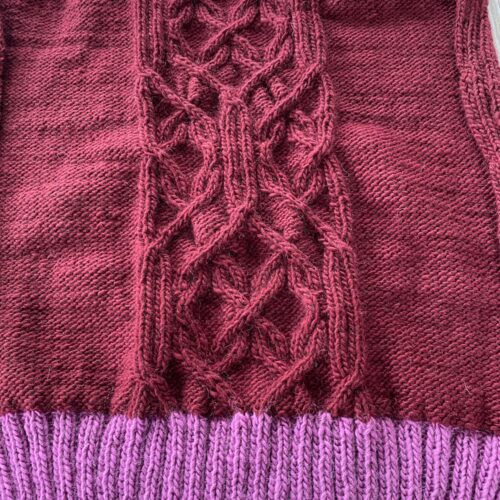adjective
characterized by windings and turnings; sinuous; circuitous: an anfractuous path.
I love a good word and this is definitely one…and in the detailed cables it lives up to its name.
In it’s construction, however, it is quite clear and straightforward. And I like that too.
It was fall of 2020, and in looking for a pattern that I could knit for myself, I wanted a sweater that
- I could throw over another shirt without being too bulky,
- warm enough for our Nebraska winters (and my lowered thermostat!)
- would give me a knit that was both engaging and simplified (more on that combo later)
- would FIT!
Sarah, aka Swanky Emu Knits, seemed to have a solution. Anfractuous. The pattern required that I take measurements and plug them into the included spreadsheet. My pattern instructions would then be populated based on MY SIZE.
I have an issue with the idea of size inclusivity even while I fall into the larger sizes myself. Most ‘size inclusive’ patterns make assumptions about the human form that don’t work for every body. Sarah’s pattern intro called out this issue and immediately got my attention. So I bit.
I’m glad I did. The pattern is for a drop-shoulder sweater, a simple shape. It is set up to use two colors, but how many is really up to the knitter…it could be done with one or five, your choice. It requires seaming, something that seems to have fallen out of fashion lately but is a necessary skill that has its uses and will never lose its place in the knitter’s toolkit. It has an intricate and heavily cabled panel running the middle of the front an back providing technical interest. All in all, it hit all the marks.
The simple shape was an inspired choice, allowing the knitter to focus on the cables and the knit without having to split the attention in order to manage shaping. Once the cable panels are complete, a basic 3-needle bind-off connects front to back. The sides each get a seam. The neck and sleeves are picked up and knit out from the body. The neck gets a short seam, weave in all the ends and viola! Done.
Well-planned, well laid-out and it has all the elements for a solid knit. I like it.
The measurements requested are basic for any sweater: chest, upper arm, neck and length from underarm to waist (or wherever you would like it to stop on YOUR BODY). Regardless of what pattern you are using you need these measurements to choose the correct size. Here they are used to interactively build the instructions for knitting the sweater itself.
What is interesting is with this spreadsheet method, the instructions will adjust to your body structure. If you have a longer or a shorter torso your underarm to waist measurement will be longer or shorter and the number of rows to complete in the cable pattern are adjusted for you. If you want a tunic length piece, go for it!
The same thing applies to wider or narrower chest measurements. Since the center panel is quite large, the sizing changes come on each side of it and are a completely adjustable. Have a belly that’s bigger than your boobs? No problem, take both measurements if you’d like and see how much you need to increase or decrease the stitches in those side panels. Extra curvy hips with a tiny waist? Same thing, run the numbers through the spreadsheet for both points and watch it provide the stitch counts. Changing the counts between those points can happen in that purl stitch panel and be hidden in the cables that run up and down the sides.
Now for those upper arm measurements…they are the bane of my knitting existence, but here, they find a proper purpose. These are used to set the armhole depth aka the arm scythe for the sweater and adjust the cable panel length. I generally knit a 48″-52″ chest, but I find many patterns give those sizes an armhole that is significantly too deep. This can be problematic since an armhole halfway to my waist adds waaaay too much extra fabric to that area and pushes the length too far down, particularly if there are any design elements at the waist/hip. And yes, 1-2″ makes a huge difference!! Here Sarah’s spreadsheet method uses them to determine the armhole independent of the body or yoke length. Woot! This was a sweet spot in the overall design for me.
As a lover of color, being able to knit this in one, two or more colors was a thing of happy-making. Color in my knitting gives me joy.
Mods? So far, only one, which for me is quite amazing and it was only due to my color choices, not the design itself. When making the color change from the hem rib to the body panel, I purled the first row on the wrong side in the new color. I’m not a fan of the purl stitch blips with strongly contrasting colors, I feel they distract from the focus of the piece — the cable panel. I did the same thing when I changed to the rib at the shoulders. If my colors were more subtle, closer in shade, heathered or had kettle-dyed tonal variations I may not have done it but with the high contrast I felt it was appropriate here.
A second mod I initially considered was taking out some of the purl panel stitches beginning at the arm hole, essentially turning the shape into a modified drop shoulder, but I didn’t. (Did I mention I often have issues with armholes?) While sometimes a drop shoulder can make me look a bit ‘mushroom-y’ with too much fabric just under the arms, I realized that the pulling in of both the cable panels and the shoulder ribbing might resolve that issue. In looking at some of the other projects that had been knit I think that may be true. I won’t find out for sure until its finished, but as long as I don’t over-block it after the wash, I don’t expect to see myself as a mushroom in it.
The back is finished and ready for the wash. I’ve started on my front panel and don’t see any issues with completion within the next few weeks. I’m looking forward to finishing this one.
My son wants one as well, he likes a good sweater to throw over a long-sleeved something when he is outside. He’s a scout and wandering about the woods in chilly weather is a thing. Then he hangs out at the campfire, comes home smelling like woodsmoke and won’t let me wash things until the smell starts to fade, it seems to help get him through the stormy, campout-cancelled weekends. Yes, smoked wool sweater is a thing at our house.
Sarah has recently released a circular yoke sweater using her spreadsheet design method. That one might have to find its way to my needles as well since that particular style of sweater is the most pronounced for my armhole-depth issues.
If you have run into issues with proper fit, you might want to try one of her designs. Using the spreadsheet was a bit of genius that I hope will help to evolve the size inclusive design process to the next level.
What kinds of issues with proper fit have you run into? No need to name names, just describe the problem and how it came about. Please share any steps you took to resolve them as that will help others fix some of the same issues.
Find your joy. Look for it…it’s out there.

